Jul 23, 2007 | Canada, commemorative, history, RCM
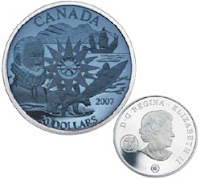 The Royal Canadian Mint is embroiled in a controversy with Inuit Tapiriit Kanatami, the Canadian organization representing four Inuit regions. This week, the RCM issued a $20 commemorative coin to mark the 125th anniversary of the establishment of research stations around the Arctic to share scientific data. It is referred to as the first international polar year. English explorer Martin Frobisher is featured on the reverse along with a 16th century ship and kayaker representing the Inuit people.
The Royal Canadian Mint is embroiled in a controversy with Inuit Tapiriit Kanatami, the Canadian organization representing four Inuit regions. This week, the RCM issued a $20 commemorative coin to mark the 125th anniversary of the establishment of research stations around the Arctic to share scientific data. It is referred to as the first international polar year. English explorer Martin Frobisher is featured on the reverse along with a 16th century ship and kayaker representing the Inuit people.
According to history, Frobisher lured an Inuit kayaker to his ship in order to bring him back to England for display. The Inuit are people indigenous of the Arctic regions of Canada and must have looked very different to the 16th century anglo-saxons from England. The captured Inuit died of disease in England.
ITK is asking the RCM to consult its organization when issuing coins about its people saying ignorance caused this mistake. The RCM is saying that they consulted experts and added the kayak as an acknowledgment of the Inuit being in the region and that it is not a commentary on those events. ITK is preparing a letter to the RCM about this coin.
Although I cannot find records of the RCM withdrawing coins, it is possible that they could cease the sale of this coin. Canada does have laws governing the fair treatment of people which could dictate what the RCM does. This is not a judgement on Canadian law. I am anticipating that if the coin does get withdraw, it will be a modern issue with a low mintage and an interesting history.
Time to go to the RCM website to order a few coins.
Image from the Royal Canadian Mint
Jul 18, 2007 | gold, history, quarter, rareties, US Mint
One of my favorite television shows is History Detectives, the PBS show where four people who have interests in various areas of antiques, history, and sociology research the background and history of artifacts people have found or had handed down to them by family members. Rather than determining the worth of an item like they do in Antiques Roadshow, the concentration is to learn about the item and its significance, or insignificance in history. Two of the History Detectives, Elyse Luray and Wes Cowen, have appeared on Antiques Roadshow.
Now in its fifth season, my local PBS television station showed the new second episode. One of the investigations was Dr. Gwendolyn Wright researching a Continental Currency $6 bill found by an Omaha, Nebraska family in a book. The story allows Dr. Wright to step outside of her area of architectural history to learn the historical significance of this note.
Rather than recap the segment here, you should visit the episode information on the History Detectives website to watch the eight minute video and read the transcript. I think you will find it as fascinating as I did.
When History Detectives are aired, the segments are concluded with another history detective giving more information about the general topic with more information. After the Continental Currency segment, Wes Cowen talked about the interesting history of US coins. Unfortunately, the two stories they used provided incorrect information.
The first mistake was saying that there was a public outcry from the public regarding the nudity on the Standing Liberty Type 1 Quarter. This myth was debunked by researcher Roger Burdette in his book Renaissance of American Coinage 1916-1921. Burdette writes that according to records from the US Mint and National Archives, designer Hermon A. MacNeil requested the change to make Lady Liberty look stronger in the face of the Great War (World War I).
The second mistake was the claim that the only legal 1933 Saint-Gaudens Double Eagle was smuggled out of the country. Although the coin was smuggled out of the Philadelphia mint, the State Department issued a legal export permit for a representative of King Farouk to carry the coin to Egypt. The State Department might have made a mistake, but that does not mean the coin was smuggled out of the country. To read more about this coin, I highly recommend the book Illegal Tender by David Tripp.
Even with these mistakes, I will continue to watch and recommend this show.
May 29, 2007 | coins, halves, history
As our 35th President, John Fitzgerald Kennedy became the youngest person to ever be elected as President and the first Roman Catholic. At 43, Kennedy was the promise of a new future; a new vision that would have the United States leading the world in fighting the “common enemies of man: tyranny, poverty, disease, and war itself.” In his inaugural address, he called the nation to arm when he said, “ Ask not what your country can do for you, ask what you can do for your country.”
From standing up to the Soviet Union’s Nikita Khrushchev, to the success of the Cuban Missile Crisis, to the failures of the Bay of Pigs, the starting of the Peace Corps, and challenging the United States’ resolve using the space program by proclaiming, “We choose to go to the Moon in this decade and do the other things, not because they are easy, but because they are hard.” In over two years, Kennedy made an impact on this country in such a short period of time that one can wonder what would had happened if….
 A few days after Kennedy’s assassination on November 22, 1963, US Mint Director Eva Adams, Chief Engraver Gilroy Roberts reported that there was discussions about putting Kennedy’s portrait on a silver coin. Since Jacqueline Kennedy did not want to replace Washington’s portrait on the quarter, it was decided to use the half-dollar. Roberts used models from the inaugural medal for the obverse design and Assistant Engraver Frank Gasparro prepared the reverse design using the Presidential Seal.
A few days after Kennedy’s assassination on November 22, 1963, US Mint Director Eva Adams, Chief Engraver Gilroy Roberts reported that there was discussions about putting Kennedy’s portrait on a silver coin. Since Jacqueline Kennedy did not want to replace Washington’s portrait on the quarter, it was decided to use the half-dollar. Roberts used models from the inaugural medal for the obverse design and Assistant Engraver Frank Gasparro prepared the reverse design using the Presidential Seal.
Since the law stated that coinage design could not be changed more often than 25 years, and that the Franklin Half was only 15 years old, it required Congress to authorize the change. The Act of December 30, 1963 allowed the design to be changed.
When the coin was released in 1964, the 90-percent silver coin was saved by a grieving nation wanting something that represented the fallen President. Over 273 million coins were struck in Philadelphia and 156 million in Denver. The composition was changed in 1965 with the introduction of clad coinage. Half dollars consisted of 40-percent silver that included a core made from 79-percent copper and 21-percent silver. In 1971, the composition was changed to current copper-nickel clad that is in use today.
 There has been one design change to the coin and that occurred in 1975 and 1976 in honor of the American Revolution Bicentennial. A special reverse depicting Independence Hall in Philadelphia was designed by Seth G. Huntington. For both years, the obverse featured the dual date 1776-1976 in celebration.
There has been one design change to the coin and that occurred in 1975 and 1976 in honor of the American Revolution Bicentennial. A special reverse depicting Independence Hall in Philadelphia was designed by Seth G. Huntington. For both years, the obverse featured the dual date 1776-1976 in celebration.
On what would have been Kennedy’s 90th birthday, we salute this great president with the coin minted in his honor. Happy Birthday, Mr. President from a grateful nation.
May 25, 2007 | cents, coins, history, US Mint
People lined the streets in front of the Philadelphia Mint on May 25, 1857 so that they can trade their foreign coins for newly minted Flying Eagle small cents. The scene must have pleased Mint Director James Ross Snowden, whose push for the coinage law passed by congress on February 21, 1857 allowed him to drive out all foreign coins from circulation.
When Snowden became Mint Director in 1853, he was faced with the issue that the price of copper and the increasing labor costs were making the large cent uneconomical to make. Snowden also knew that for the nation to continue to thrive, the lower denomination foreign coins that were still being used in the United States had to be removed from the economy. Aside from the large cent not being popular with the public, Snowden also believed that the value of subsidiary coinage can be based on trusting the government as the issuing authority and not necessarily the intrinsic value of the metals used.
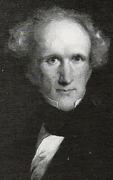 Snowden tasked James B. Longacre with designing a smaller coin to replace the large cent. Longacre borrowed the Christian Gobrecht/Titian Peale design that was used on pattern dollars twenty years earlier to create a unique obverse. For the reverse, Longacre adapted the wreath he made for the 1854 one and three dollar gold coins. Snowden ordered 1,000 of these 1856 Flying Eagle Cents to struck in order to distribute to congress and other politicians as part of his lobbying effort to allow for their regular production.
Snowden tasked James B. Longacre with designing a smaller coin to replace the large cent. Longacre borrowed the Christian Gobrecht/Titian Peale design that was used on pattern dollars twenty years earlier to create a unique obverse. For the reverse, Longacre adapted the wreath he made for the 1854 one and three dollar gold coins. Snowden ordered 1,000 of these 1856 Flying Eagle Cents to struck in order to distribute to congress and other politicians as part of his lobbying effort to allow for their regular production.

 At least 634 of these pattern coins were distributed amongst official Washington. Although many of the politicians liked the coins, it did not produce immediate action. Snowden continued to lobby congress for the new coin and the demonetization of foreign coins circulating in the United States until the coinage law was passed.
At least 634 of these pattern coins were distributed amongst official Washington. Although many of the politicians liked the coins, it did not produce immediate action. Snowden continued to lobby congress for the new coin and the demonetization of foreign coins circulating in the United States until the coinage law was passed.
Without waiting for the bill to be singed by President Franklin Pierce, Snowden ordered news dies to be made and a large number of coins to be struck. Although the exact number ordered is lost to history, it is estimated that between two or three million Flying Eagle cents were struck.
On May 25, 1857, the Mint constructed temporary wooden teller windows to trade the new cents for subsidiary foreign coins that were demonetized by the new law. The new coins were a success and the Mint went on to strike over 42 million of these coins driving all demonetized foreign coinage out of the market.
Longacre’s design was difficult to strike because of the relief and the placement of the eagle over the reverse elements. So the Flying Eagle design lasted two years with attempts at a die change in 1858. Snowden changed the design in 1859 to the Indian Head cent claiming the relief was too high and the design was not accepted by the public. Although the explanation has been disputed, Snowden was successful with introducing a coin that was accepted by the public and driving out foreign coins—150 years ago today.
Longacre portrait courtesy of uspatterns.com
May 20, 2007 | coins, currency, fun, history
Yes, I know the John Adams Dollar was released this week. But Real Life™ got in the way and I was not able to go downtown Washington to buy first day of issue coins. For now, I will by pass talk of the Adams Dollar in favor of some fun.
The Futures Channel is an online video service that creates multimedia content to bridge the gap between the Real World™ and the subjects students are learning in school. It is a great idea with interesting results. Two videos that I thought would be of interest to numismatists, collectors, and hobbyists are First American Coins and Printing Money.
Although First American Coins does not mention where it was taped, there are mentions of the ANA World’s Fair of Money that was held in Denver the Summer of 2006. Amongst the video’s vignettes is a picture and discussion of the Brasher Doubloon as the first US gold coin and the half dismes as the first silver coins made from George and Martha Washington’s silver.
Printing Money also has images from the ANA World’s Fair of Money in 2006, but also has what appears to be stock footage that is rumored to have been provided by the Bureau of Engraving and Printing. Still, it is an interesting video.
Both videos make an attempt to tie the content back to mathematics in order to provide benefits for the students. For the rest of us, it just interesting.
Apr 30, 2007 | coins, history
George Washington was President of the United States. The United States Senate held its first public session in 1794. Eli Whitney patented the cotton gin. The Whiskey Rebellion occurred when farmers in the Monongahela Valley of Pennsylvania rebelled against federal liquor taxes and the army was called in to put down the uprising. Fort Wayne was founded.
Matthew Perry, an American commodore who was instrumental in opening relations with Japan, was born on April 10. Cornelius Vanderbilt, entrepreneur and first railroad tycoon, was born on May 27. Abraham Clark and John Witherspoon, both signers of the Declaration of Independence died that year.
Alexander Hamilton was the Secretary of the Treasury but the US Mint was under the Secretary of State Edmund Randolph. David Rittenhouse was the first Director of the US Mint. Robert Scot was the first Chief Engraver of the Mint. In 1794, only half-cents and large cents were minted because the money for surety bonds could not be raised in order to allow for the minting of silver coins. Even though there were half dismes struck with the 1794 date they were actually minted in 1795.
Two hundred and thirteen years have passed since 1794. We have seen wars and peace; prosperity and poverty; great philanthropists and robber barons. We have transformed our economy from agrarian through the industrial revolution that saw great factories built only to be replaced by a largely service-based economy. We had presidents whose grand monument in South Dakota is dwarfed only by their achievements, presidents who left in violence, to presidents who left in shame.
 What has this country seen in 213 years? Imagine holding in your hand a coin that reads “ONE CENT” that has been worn over time and has a barely readable date of 1794. The edge lettering is worn away. This coin once helped feed someone, maybe a family. This coin may have helped a family with housing. It may have seen the pockets or great men or the purses of great women. It could have provided a worker with libations in a dockside pub or a moment of release for someone down on their luck. It was part of the birth of a nation and stay around as it matured.
What has this country seen in 213 years? Imagine holding in your hand a coin that reads “ONE CENT” that has been worn over time and has a barely readable date of 1794. The edge lettering is worn away. This coin once helped feed someone, maybe a family. This coin may have helped a family with housing. It may have seen the pockets or great men or the purses of great women. It could have provided a worker with libations in a dockside pub or a moment of release for someone down on their luck. It was part of the birth of a nation and stay around as it matured.
In 1794, Robert Scot added the Liberty Cap, a Phrygian cap on a Liberty Pole, behind the effigy of “Liberty” to symbolize the country’s freedom. It was reported that 918,521 of these pure copper coins were minted. Like the country that minted it, this coin has survived.
When someone asks why I collect coins, I show them this old and worn 1794 Liberty Cap Large Cent and ask if they can imagine what this coin may have seen. It is an awesome thought!
Mar 12, 2006 | coins, currency, history, medals, silver
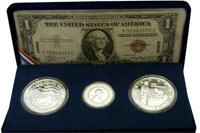 In this time of uncertainty, I feel that we Americans need to remember those who have given their lives in defense of this country. This is not a political statement on the current Middle East situation, but an appreciate of those with their boots on the ground who risk their lives daily. As part of that, my wife and I visited the U.S.S. Arizona (BB-39) Memorial at Pearl Harbor during our trip to Hawaii. Unfortunately, rain prevented us from visiting the U.S.S. Missouri (BB-63) Memorial.
In this time of uncertainty, I feel that we Americans need to remember those who have given their lives in defense of this country. This is not a political statement on the current Middle East situation, but an appreciate of those with their boots on the ground who risk their lives daily. As part of that, my wife and I visited the U.S.S. Arizona (BB-39) Memorial at Pearl Harbor during our trip to Hawaii. Unfortunately, rain prevented us from visiting the U.S.S. Missouri (BB-63) Memorial.
In front of the gift shop that is inside the Visitors Center was a table with gentleman selling Pearl Harbor commemorative medals and sets produced by the Honolulu Mint. I was very intrigued by the items and gravitated to the commemorative set that contains two .999 Silver, 1 Troy Ounce medals, an uncirculated 1943 Steel Lincoln Cent, and a Series 1935A Hawaii issue Silver Certificate. Even though I am not a commemorative collector, I do tend to buy numismatic items from my personal experiences. While standing in the Memorial, and with my wife’s urging, I could not pass up buying this set.
-
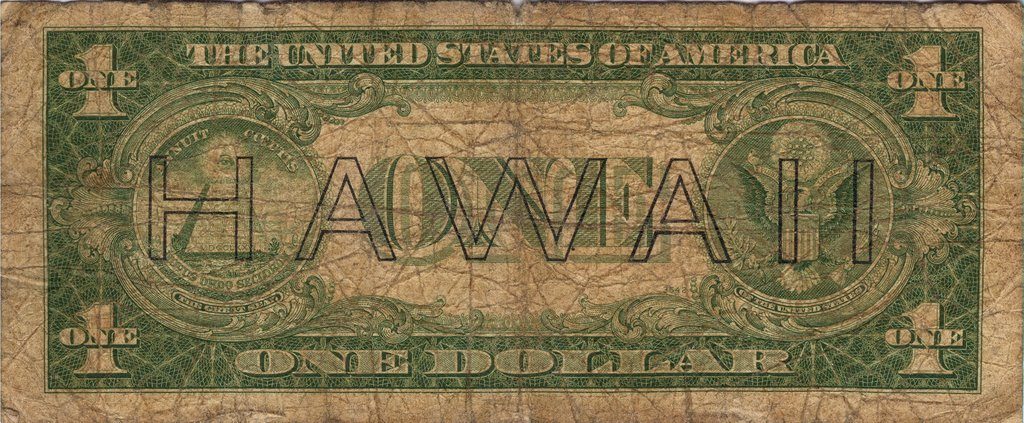
-
Series 1935A Silver Certificate with “HAWAII” Overprint Reverse
The set includes a medal commemorating the 65th Anniversary of the Japanese bombing of Pearl Harbor. The obverse shows the U.S.S. Arizona and the anniversary date. The reverse shows an arial view of the memorial with the outline of the sunken ship in the water. On the image are the words “Honoring all those who made the ultimate sacrifice on Dec. 7, 1941.”
-
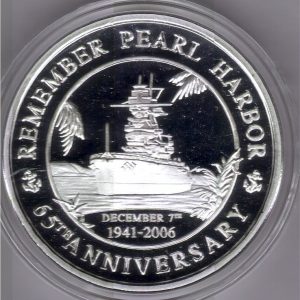
-
Obverse of the Pearl Harbor 65th Anniversary silver medal
-
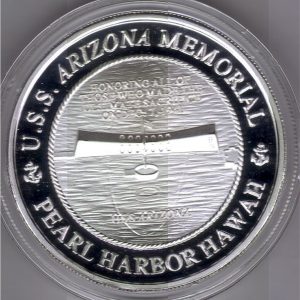
-
Reverse of the Pearl Harbor 65th Anniversary silver medal
The other medal commemorates the Japanese surrender aboard the U.S.S. Missouri. It was prophetic that the articles of surrender were signed on her deck. The obverse of this medal recreates the signing of the document by General Yoshijiro Umezu, Chief of the Army General Staff, with Lieutenant General Richard K. Sutherland standing across the table. The reverse has the inscription on the deck of the Missouri where the articles were signed.
-
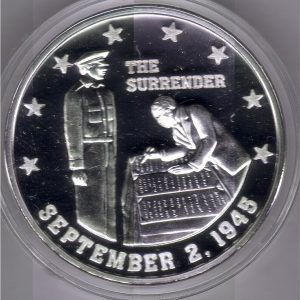
-
Obverse of the Japanese Surrender Silver Medal
-
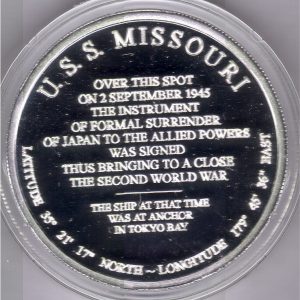
-
Reverse of the Japanese Surrender Silver Medal
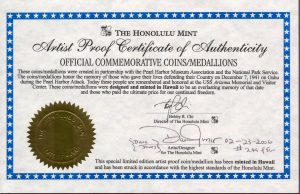
Personally autographed COA from the Honolulu Mint
Although everyone should visit the U.S.S. Arizona Memorial and the rest of Pearl Harbor, I know it is not a trip that every can take. So if you are interested in this collectible and other medals honoring those who served and gave the ultimate sacrifice, you can visit the Honolulu Mint’s website or the U.S.S. Arizona Memorial Bookstore. Portions of the proceeds benefit the Memorial.
 The Royal Canadian Mint is embroiled in a controversy with Inuit Tapiriit Kanatami, the Canadian organization representing four Inuit regions. This week, the RCM issued a $20 commemorative coin to mark the 125th anniversary of the establishment of research stations around the Arctic to share scientific data. It is referred to as the first international polar year. English explorer Martin Frobisher is featured on the reverse along with a 16th century ship and kayaker representing the Inuit people.
The Royal Canadian Mint is embroiled in a controversy with Inuit Tapiriit Kanatami, the Canadian organization representing four Inuit regions. This week, the RCM issued a $20 commemorative coin to mark the 125th anniversary of the establishment of research stations around the Arctic to share scientific data. It is referred to as the first international polar year. English explorer Martin Frobisher is featured on the reverse along with a 16th century ship and kayaker representing the Inuit people.












